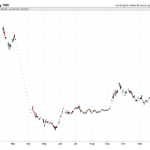Silver suffered a severe setback during the 2008 global financial crisis, which had a profound impact on the world’s economy. The crisis had its roots in the U.S. subprime mortgage market, which collapsed in 2006, triggering a chain reaction that eventually spread throughout the world’s financial markets. The crisis had severe consequences for all asset classes, including precious metals like silver.
This article aims to provide an analytical overview of the performance of silver prices during this tumultuous period, examining daily price data and market commentary, as well as providing historical context and insights into the broader economic events that shaped this period.
The 2008 financial crisis was a defining moment in modern economic history, with far-reaching implications for global markets and economies. The crisis upended the traditional expectations of financial stability and exposed the vulnerabilities of the global financial system. Silver prices were not immune to this upheaval, and this article seeks to explore their performance during this time.
By analyzing the trends and fluctuations of silver prices from July to December 2008, we hope to provide a framework for understanding the impact of the crisis on this precious metal and its role as a safe-haven asset.
It is important to note that while this article uses online price data, the limitations of such data for speculative purposes are acknowledged, and the focus is on providing an objective and analytical perspective on the market performance of silver during this period.
Market Performance
The market performance of silver during the 2008 financial crisis was marked by significant fluctuations in prices, as reflected in the daily silver price data from SD Bullion. Silver prices ranged from $19.30 oz on July 16, 2008, to $8.88 oz on October 27, 2008, illustrating the volatile nature of the precious metal market during times of economic uncertainty.
Factors influencing the fluctuation of silver prices during the financial crisis included the rolling credit shocks and bank crashes that led to a worldwide economic recession from 2007-2009, the European Central Bank’s emergency cash injections, and several bank collapses in Britain, USA, Germany, and elsewhere over the following 18 months.
Despite the significant fluctuations in silver prices, the 2008 financial crisis also presented investment opportunities for those who were able to capitalize on the market volatility. Average premiums of 1 oz American Silver Eagle Coins above Silver Spot Prices increased to over 80% in the fall of 2008, demonstrating the demand for physical precious metal bullion products for asset preservation and allocation.
While using online price data, market commentaries, and opinions for speculative purposes was not advised, the eventual increase in silver prices to nearly $50 oz by spring of 2011 highlights the potential benefits of investing in silver during times of economic uncertainty.
2008 Financial Crisis Overview
Quantitative easing programs were implemented by governments and central banks to address the rolling credit shocks and bank collapses that led to a worldwide economic recession from 2007-2009.
One of the main causes of the 2008 financial crisis was the subprime mortgage crisis in the United States, which led to a sharp decline in housing prices and a significant increase in foreclosures.
This crisis spread to the global financial system, as banks and financial institutions that held mortgage-backed securities suffered significant losses and were forced to write down their assets.
The crisis also led to a decline in consumer confidence, which resulted in a decrease in spending and a slowdown in economic growth.
The consequences of the 2008 financial crisis were far-reaching and long-lasting.
The crisis led to a significant increase in unemployment, as many companies were forced to lay off workers or reduce their hours.
It also led to a decline in economic growth, as businesses struggled to access credit and consumers were hesitant to spend money.
In response to the crisis, governments and central banks implemented a range of measures, including quantitative easing, to stimulate economic growth and stabilize financial markets.
While these measures were successful in preventing a complete collapse of the financial system, they also led to a significant increase in government debt and raised concerns about the long-term sustainability of the global economy.
Impact on Silver Prices
With the global economic recession of 2007-2009 and subsequent financial rescue packages, the value of silver experienced a significant shift. The performance of silver during this time was influenced by various factors, including investor sentiment, supply and demand dynamics, and monetary policy decisions. The silver market saw significant volatility during this period, with prices fluctuating widely in response to changing market conditions.
Factors influencing silver prices during the financial crisis included a surge in investor interest in safe-haven assets amid rising economic uncertainty and a decline in industrial demand due to the economic slowdown. Additionally, monetary policy measures such as quantitative easing implemented by central banks to stimulate economic growth and stabilize financial markets also had an impact on silver prices. Overall, the financial crisis highlighted the importance of silver as a store of value and safe-haven asset, and its performance during this period underscores the need for investors to closely monitor market conditions and adjust their portfolios accordingly.
| Date | Silver Price (USD/oz) | Factors Influencing Price |
|---|---|---|
| Jul 15, 2008 | $19.30 | Rising investor interest in safe-haven assets |
| Oct 27, 2008 | $8.88 | Decline in industrial demand due to economic slowdown |
| Dec 18, 2008 | $11.29 | Monetary policy decisions and market volatility |
Frequently Asked Questions
What was the global demand for silver during the 2008 financial crisis?
During the 2008 financial crisis, global supply of silver exceeded investment demand, resulting in a surplus. However, industrial demand for silver remained relatively stable, particularly in the electronics and solar industries.
How did the price of silver compare to other precious metals during the crisis?
During the 2008 financial crisis, silver prices were volatile, fluctuating from $19.30 oz on July 16 to $8.88 oz on October 27. Comparing silver to gold and platinum, silver had a higher percentage increase in price. Industrial demand also impacted silver prices during the crisis.
Were there any notable events or factors outside of the 2008 financial crisis that impacted silver prices during this time period?
Silver demand drivers such as industrial and jewelry demand, as well as the impact of political events such as the US presidential election, tensions with North Korea, and changes in mining regulations, may have influenced silver prices during the 2008 financial crisis.
What was the average daily volume of silver traded on forex markets during this time period?
The daily trading volume of silver on forex markets during the 2008 financial crisis is not specified in the given background information. However, market trends indicate that silver prices fluctuated greatly during this time period due to the crisis and subsequent quantitative easing programs.
Did the price of silver experience any significant price manipulation or market manipulation during the 2008 financial crisis?
There is evidence of price manipulation and market intervention in the silver market during the 2008 financial crisis. The Commodity Futures Trading Commission found that JPMorgan Chase had engaged in "repeated manipulative conduct" in the silver futures market during this time period.





